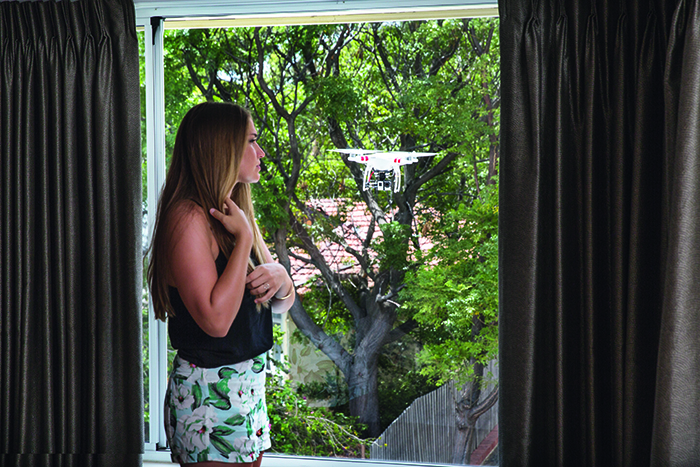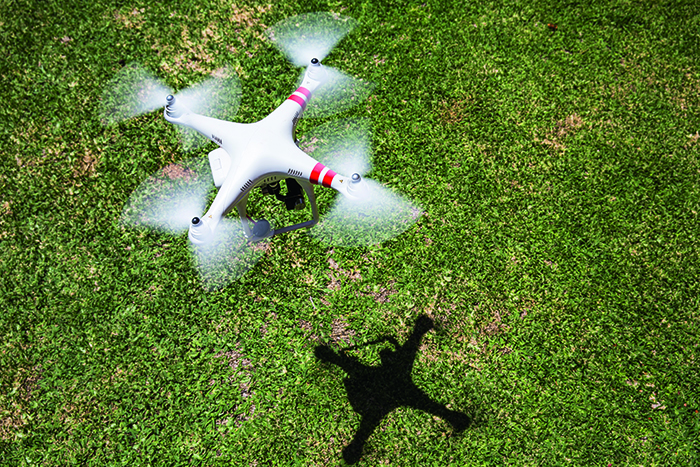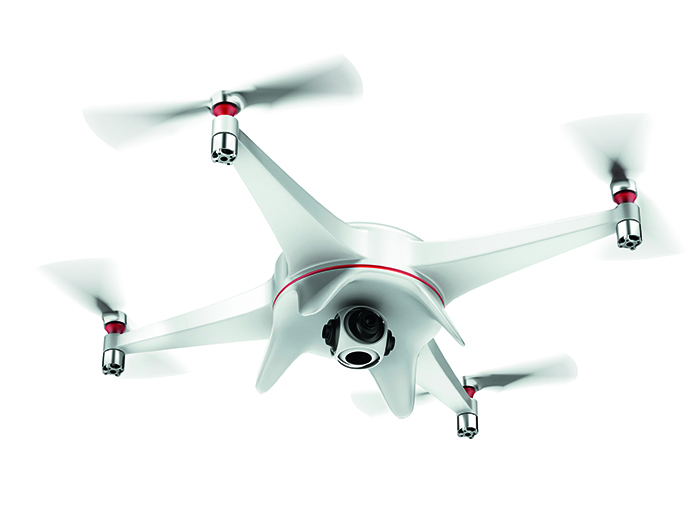From peeping in windows to protecting our beaches, drones take surveillance to new heights.
Look! Up in the sky! It's a bird! It's a plane! It's… um..."
No, it's definitely not Superman: any extraordinary aerial presences that may be spotted across Perth right now come sans capes. Call them UAVs (unmanned aerial vehicle), RPAs (remotely piloted aircraft), quad copters or simply drones, the fliers are the result of a perfect storm of improved global positioning systems, powerful batteries, microelectronics and lightweight materials.
Resembling giant flying spiders, the machines are operable from a controller, computer, transmitter or smartphone, and, thanks to the high-definition cameras mounted on them, afford a bird's-eye view of… well, just about everything.
But despite their – some might say – creepy appearance, these drones are indeed used to help out in areas where Superman has failed to pick up the slack, from searching for lost mountain climbers to mapping fire zones in the dark to help firefighters combat a blaze.
Less heroic – but equally useful – are the drones that allow scientists to access remote areas of the planet for research, or film documentary footage of humpback whales in activities never before seen by the human eye. On a more modest scale, they can even be used to deliver online purchases within minutes: Amazon Prime Air is currently being tested in the United States, and awaits the result of legislation that will allow testing to be done outdoors. A successful outcome would see online purchases delivered to the front door shortly after ordering. Now that would really give the family dog something to bark about.
All of this is without even touching on all the obvious space probe and military applications for which the aerial apparatus can be used. The Civil Aviation Safety Authority (CASA), which is responsible for Australia's enforcement of the safety regulations regarding drones, currently identifies 650 commercial applications for the machines. No one is more excited about that than Joshua Portlock, the Perth-based robotics engineer who has received international recognition as the Australian pioneer of drone technology.

Perth drone pioneer Joshua Portlock, with his NASA-approved cyberQuad unit.
Having built a successful business over the past six years, his Balcatta factory, Sci.Aero, is like something from a science fiction film. Within, Portlock and his team of experts manufacture safe drones – cyberQuads – and then train people to fly them for all sorts of missions.
These robots, the first of their kind, have already clocked up thousands of hours of air time in their work in the oil and gas industry. "BHP and Woodside use cyberQuads to inspect their mine sites and oil rigs," says Joshua of the devices, which employ four ducted fans and a high-definition camera. "The most dangerous part of the oil rigs is the live flare tips – big fireballs coming out of the top of the towers. Without the drones, the company would have to close the rigs down for a couple of days to do the inspections, and would lose production."
Animal activists, meanwhile, have also praised the groundbreaking invention, after drones shot footage of dolphin poachers in the Solomon Islands, video that was broadcast on the Animal Planet television network. Drones were also used – albeit unsuccessfully – in the search for missing Canadian hitchhiker Prabhdeep Srawn on Mount Kosciuszko, and in the efforts to control the Hazelwood mine fire in Victoria.
Joshua, with his business partner Paul Deuchar, is now working on further applications of drones with Bondi Surf Lifesaving Club, and has pitched the use of the machines to the WA State Government for spotting sharks along the coastline. "We can station drones along the beach at each surf club and reduce thousands of dollars of costs in manned helicopter operations," he says.
In the meantime, Joshua and his robots are about to hit the US market, where he hopes to expand operations. Establishing early this year, the company's office in Houston, Texas will be a base to explore the oil and gas market through North America.
It's a development that builds on the landmark decision by NASA to certify the cyberQuad to operate in commercial airspace in the United States – the first multi-rotor unmanned aerial vehicle to achieve such clearance. "It really was a proud moment to see that machine flying around the Kennedy Space Centre," Joshua says.

There are in the vicinity of 200 licensed commercial drone operators in Australia, but that figure pales in comparison with the number of recreational drone users. CASA estimates that there are tens of thousands of operators who have been drawn to using drones for the thrill of flying while remaining safe on the ground.
Every weekend, enthusiasts – usually male – arm themselves with goggles and transmitters and head to remote bushland around Perth to race their new toys. Interest in the hobby reached its peak in Perth over Christmas last year, when online and retail outlets reported the drones to be flying off the shelves. That's certainly the case at Gerry Gibbs Camera Warehouse in Cannington, which has done a brisk trade in a whole range of drones since introducing them to the Perth market the previous Christmas.
"We move a lot, to people here and in the eastern states as well," says the
store's Bill O'Donohoe. The most popular model? "The Phantom has
the lion's share," he says. "We sell mainly to hobbyists who want to know where the fish are biting and want to photograph remote locations. Costs start at $699 and go up to thousands."
Perth bricklayer Jason – who prefers his identity be kept secret because of the way the public perceives drone users – has made a collection of the flying machines at home, and regularly races them with his mates north of Perth.
Describing the thrill of steering the drone as it soars up above as "the closest thing you can get to flying like a bird as you are standing firm-footed on the ground," he compares it to flying a model aeroplane, "but 100 times better, and highly addictive".
Brendan Lake, of Subiaco, bought his Phantom quadcopter online from Hong Kong. His $1300 outlay also secured two spare propellers and a pamphlet of safety instructions from CASA, not to mention serious cachet among his mates. Operating the drone from his mobile phone, he takes aerial footage of terrain that takes his fancy, and then posts it on YouTube. He's also building up a database of aerial photographs of development sites for apartments while he works on a business plan.

Brendan's Phantom can fly up to 300m away and, using his iPhone to control it, he regulates its maximum height at 120ft (37m). When the battery starts running out, the drone automatically heads back to base. "It's great because you get quite a unique perspective of places," says Brendan. "I've seen some great footage online, taken of surfing and concerts."
But for all the beneficial applications of these machines, and all the enjoyment they bring to hobbyists, the backlash has been fast arriving, following a slew of controversial and widely reported incidents that have shown the flipside of drone use. For every smiling enthusiast, there's a growing band of disgruntled people wishing for giant fly swats...
For many, it's worries over everything from privacy to safety that have sparked calls for tighter regulation of drone useage. In the United States, anti-drone sympathies have been spreading since 2012, when Pulitzer Prize-winning columnist Charles Krauthammer predicted that the first person who employs the Second Amendment (the right to keep and bear arms) to use a weapon and bring down a drone would be a folk hero.
Closer to home, one of the most well-publicised cases of drone abuse came last November, when a Victorian woman was accidentally snapped in her backyard by a real estate agent's drone while she sunbaked in her g-string. Mandy Lingard, a grandmother, was horrified when she spotted herself in a photograph on an advertising board on her neighbour's property.
Cases of drones causing damage to property, and even physical harm to people have done nothing to improve the way the devices are viewed. In Perth alone, two incidents raised eyebrows and concerns: in Daglish, one woman had her festive period interrupted when a drone crashed into the family car. "Just as we were wrapping up Christmas lunch, the kids come running in, screaming, 'A helicopter just crashed into our car!!'" she wrote on Gumtree. "If this drone belongs to you, please email me."

Then there was Perth triathlete Raija Ogden, who suffered head injuries during an event in Geraldton last year. As she approached the finishing line, a drone crashed into her, forcing her to abandon the race. Her injuries required three stitches and she was concussed for 10 days – the incident made international news.
Warren Abrams, whose daughter was controlling the drone, was slapped with a $850 fine by CASA for infringing their rule dictating a minimum no-fly distance around vehicles, boats, buildings or people. Abrams, who bought the drone to use on his farm, has now abandoned it and wants to forget the whole thing. "I certainly won't be using it anymore," he says. "I was just helping out with the race, but after that I have been put off completely."
Nor is the potential for injury as a result of drone use limited to individuals. In May last year, passengers on a chartered aircraft from Kambalda were horrified when their plane narrowly missed colliding with a drone as it came in to land at Perth Airport. Mystery still surrounds another incident, which occurred in Newcastle three days later, when a Westpac rescue chopper almost collided with an unmanned craft flying within 100m of it.
Such incidents are on the increase, according to reports from the Air Traffic Safety Board (ATSB). "Since January 2010, there have been 27 occurrences involving RPA, 10 of which relate to recreational drone encounters," says Carl Fellows, spokesman for the Board. "And in the last few months of 2014, another 10 were reported but have not yet been assessed."
Those who have been affected by such incidents, have turned to the media and the internet to vent their frustration. "How ridiculous is that, to be able to just buy drones online?" says one contributor to an internet forum. "They're very dangerous and obviously available to terrorists who could bring other aircraft down," says another. Even those who use drones recreationally, and with the best of intentions, are taking to message boards to bemoan the situation: "[It's] the usual minority ruining it for us, the majority who enjoy RC (remote control) plane flying."
When it comes to commercial useage, controls and education appear to be well governed. Sci.Aero offers training on how to operate commercial drones, the only pilot school in WA to do so. The two-week course, which costs $5000, puts participants in a flight simulator and takes them through the theoretical and practical aspects of flying, with emphasis on reading charts and weather maps and air traffic. Participants then graduate with a Remote Pilot Licence, which is recognised by CASA and allows them to fly drones for commercial gain under an operator's certificate.

But even with training and regulations in place for commercial users, the rules are still indistinct, with some confusion over what actually qualifies as commercial use. Take the case of one filmmaker, who has used his personal drone to capture film footage of whales for a documentary he's making. He's worried he'll be fined because CASA would see him as using his drone for commercial gain, which requires a licence – one he doesn't possess. CASA, however, says he probably wouldn't be fined – with the emphasis on 'probably'.
"Someone, without a licence, using a drone to capture footage and then using that footage in a documentary would be unlikely to be prosecuted," says Peter Gibson, spokesman for CASA. "There's a big difference between someone who sets up a company using drones for a commercial purpose and getting paid for it, and someone who has captured footage with their own personal drone and then that footage ends up in a film." He adds, however, that each case would be looked at separately.
Where things become murkiest, however, is with out-and-out recreational users. At the moment, such users require neither a licence nor training in order to use a drone: when it comes to drone operation and ethics, many are simply self-taught. Perth hobbyist Jason, for instance, says he learned to fly his in about five minutes. While he always operates under the safety regulations issued by CASA, not everyone is so meritorious – and it's those who abuse the system, he says, who have created the poor public image of drone hobbyists.
"There is a lot of misinformation out there and there are a few idiots who are ruining it for everyone," he says. "The propellers are dangerous. They can do some damage, cut fingers and things like that. And you know not to fly them in built-up areas, always fly them in line of sight and don't fly over houses." CASA safety regs require no flying closer than 30m to vehicles, boats, buildings or people, no operating a drone within 5.5km of an aerodrome or helicopter landing pad, and no flying above 400ft (122m).
Jason is also aware of the privacy aspect – something not controlled by CASA, rather by local council bylaws and the Office of the Australian Information Commissioner. The issues, he says, are the same as for the use of CCTV technology, which has been around for a long time.
"Satellites can take pictures of anyone from outer space," he says. "None of us have really got any privacy any more. And, people should use their common sense. Don't go within 30m of people and don't take pictures of them which you are going to publicise."
Gerry Gibbs Camera Warehouse supplies a pamphlet outlining safety regulations, but staff baulk at offering privacy or insurance advice. "We are not qualified to do that," says Bill O'Donohoe.
But then, even the police admit that the legal situation covering drones is confusing. "If property is damaged because of a drone it is a 'time, place, circumstance' thing, and would depend on if someone laid a complaint and there would be an issue with exactly where the drone was and how far away it was from a person," says a media liaison officer for the WA Police.
"As for the privacy issue, that is one of the grey areas. Laws have definitely not caught up with technology."

Both the police media and CASA quote the Privacy Commissioner as the go-to source for help, should a person feel their privacy has been invaded. But in 2014, Privacy Commissioner Timothy Pilgrim wrote to the Federal Government warning that the Privacy Act did not cover the use of drones by individuals, nor by business with an annual turnover of $3 million or less.
However, a federal parliamentary committee, headed by coalition MP George Christensen, has made six safety and privacy recommendations to the Government to simplify things for everybody. These include a review of laws regulating use of surveillance devices (including drones), and a review of laws that regulate police use of surveillance drones, with a focus on modernising legislation and making it nationally uniform.
Tom Percy QC, the state president of the Australian Lawyers Alliance, is one of many in Australia awaiting the outcome. People who believe their privacy is being invaded by a drone flying within 30m of them or their property could apply to a magistrate for a misconduct restraining order, he says. That is, if they can establish the identity of the person operating the drone.
"That is just the same situation as if someone was throwing rubbish over your fence or filming your personal activities from a nearby property," he says. "Difficulties arise when the perpetrator of the problem isn't known."
While CASA may be in the throes of rewriting its regulations in order to clarify things for both commercial and hobbyist operators, Tom agrees with WA Police that there is a significant gap in the law, and urges the Federal and State governments to act swiftly on it.
"It is incumbent on the various legislative bodies around the country to legislate on these grey areas sooner rather than later," he says. "People need to know things like whether they are entitled to take possession of a drone that's bothering them. At this stage, given the comparative dearth of legislative provisions in the area, I couldn't give you a definitive answer."
Fly Swatting
Get up to speed with the current guidelines for drone use, as provided by CASA's website.
-
It is illegal to fly a drone for money or economic gain unless you have an Unmanned Operator's Certificate,issued by the Civil Aviation Safety Authority.
-
�Do not fly closer than 30m to vehicles, boats, buildings or people.
-
�Do not operate within 3nm or 5.5km of an aerodrome or helicopter landing site without approval.
-
�Do not fly above 400ft (122m).
-
Do not fly over any populated areas such as beaches, other people's backyards, heavily populated parks, or sports ovals where there is a game in progress.
-
�Only operate your RPA during daylight, in good weather and in line of sight.
-
�FPV (first person viewing) flying may be illegal without an Advance Amateur Radio Licence.